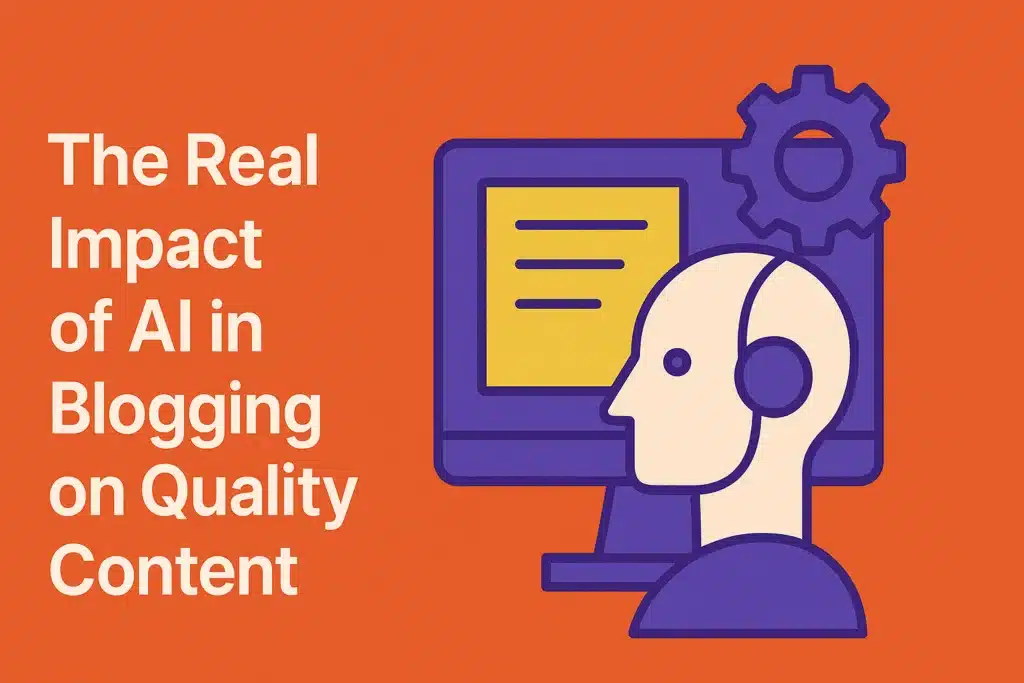AI in blogging changes how authors plan and produce content. It combines classic writing with modern tools, guiding writers toward based on data decisions. Many adults seeking insights notice how AI speeds up creation while retaining a real feel. This approach frees time for deeper ideas while improving the standard of each article.
Overview
Modern readers want concise, direct answers without unnecessary complex details. AI’s role in blogging includes faster research, sharper editing, and structured planning. By reducing repeated tasks and creating suggestions, it keeps fresh thinking active. Writers and brands actually gain from tools that increase engagement and always meet audience needs effectively.
How AI is Improving Content Creation Workflows
AI tools minimize uncertainty in writing by addressing audience demands more accurately. Many creators see quicker research, automated editing, and fresh topic suggestions. This approach lowers overhead and time-to-publish rates for bloggers in multiple niches. By simplifying tasks, AI consistently improves and delivers content that meets modern standards.
Speeds up topic research using language models
Language models process vast datasets to identify popular subjects with ease. According to research, AI tools can produce content up to 10 times faster than previous models [LinkedIn]. This speed helps writers address current reader interests immediately. Instead of manually searching large amounts, bloggers gain specific topics that address timely queries. The result is better relevance, stronger engagement, and a simplified workflow. AI’s based on data insights also improve planning decisions. Many brands also reduce costs.
Automates drafts and editing for faster turnaround
Bloggers spend less time rewriting and more time publishing when AI tools create initial drafts. Some platforms let users produce refined text in under 10 minutes [Pressmaster.ai]. These systems check grammar, adjust formatting, and track performance across channels. Near-instant editing cuts production cycles significantly, leading to a higher volume. Bloggers can even schedule content across platforms from a single interface. This remote-focused process reduces manual tasks and keeps production deadlines on schedule without compromising brand guidelines.
Reduces writer’s block by generating smart suggestions
Staring at a blank page often slows creativity. AI solutions suggest prompts, rewrite content in multiple styles, and track audience interests [Toolify]. These platforms provide opening lines or story angles, which start the entire writing process. They outline relevant details and offer style shifts. By addressing the hardest parts of writer’s block, AI allows authors to regain productivity quickly. This help enables them to create consistent posts and maintain a tone that appeals to their niche, with less work.
Top 5 Benefits of AI in Blogging
Bloggers appreciate the practical benefits AI brings, including flexible custom and faster editing. These benefits increase loyalty and improve search rankings. AI also tracks performance data and suggests new content approaches. By highlighting five main advantages, writers see how these tools raise blogging standards higher over time.
1. Boosts content quality with predictive analysis
AI identifies audience focus patterns, which helps bloggers create content that connects well. By analyzing earlier posts, it shows which parts improved engagement. This info guides writers to develop content with stronger headlines and targeted keywords. Over time, predictive methods adjust quality thresholds and keep posts relevant. Bloggers avoid uncertainty and rely on proven practices, which raises reader satisfaction. This focused approach reduces the chance of outdated or irrelevant pieces that might lower credibility.
2. Enhances SEO through optimized keyword usage
Effective keyword placement improves a blog’s rank on search pages. AI-powered tools analyze massive datasets to find terms that match user intent. This method saves hours of manual research and adapts to changing search patterns. Traditional SEO once relied on trial-and-error, but with AI in blogging, it combines speed and precision. Google’s engaging pages now respond to prompts quickly, so well-optimized posts appear more easily [ResearchFDI]. Writers who use these strategies achieve consistent rankings and overall better traffic.
3. Personalizes content for improved user engagement
Blogs become noticeable when they speak directly to each reader. AI custom-content tools analyze user behavior, time on page, and click history. This analysis shows which tone, format, or subjects attract people most. Suggesting matching posts or products based on preference increases user retention. By dividing readers, creators create material that addresses each group’s specific concerns. This approach creates stronger connections and increases conversions. AI-driven custom approach encourages lasting loyalty over quick clicks.
4. Helps maintain tone and consistency in brand messaging
A consistent style defines brand image. AI-based assistants review word choices and identify off-brand expressions. By learning a company’s voice profile, these systems match the brand tone well for captions or marketing copy. They also apply consistent grammar, vocabulary, and visual guidelines. Bloggers managing multiple social platforms can save time by letting AI create consistent updates. A consistent brand message builds trust and helps audiences recognize the name quickly. This clearer identity also increases recognition in followers.
5. Enables multilingual content creation at scale
Companies expand reach by creating posts in multiple languages without significant overhead. Language models like ChatGPT can work with various languages, including Spanish and Chinese [t’works]. This capability opens up new audiences and expands a blog’s global presence. Writers can modify posts quickly and keep the tone accurate in each translation. While specialists still check localized nuances, AI reduces the initial work. This efficient method supports global marketing objectives and simplifies entering new markets with less difficulty.
How the Benefits of AI in Content Writing Are Transforming Blogging
Writing teams succeed when new ideas appear more quickly and posts remain matching current search trends. AI supports that by providing factual data, better user targeting, and simplified editing features. Many creators see fewer revision delays and more strategic insights. The benefits make a clear effect on growing success across platforms.
Provides data-backed decisions for topic selection
AI-driven topic selection decreases uncertainty. These tools present data on what readers want, based on trending queries and competitor studies [Vengreso]. This data-driven approach avoids random attempts or repeated themes. Writers analyze that data to identify new perspectives and match changing audience tastes. By reviewing search volumes alongside user patterns, they pick subjects likely to drive traffic. This step removes random trial-and-error and ensures each post connects well. The result: more relevant articles and more satisfied readers.
Matches content with user intent for better performance
AI identifies user objectives, ensuring each post covers the right aspects. By analyzing browsing habits, time on page, and returns, it creates a customized method . This match improves blog output, as readers find direct responses fast. Writers rely less on assumptions about preferences. Instead, they refine posts to match specific needs. The result is higher click-through rates, lower bounce rates, and a loyal following. AI builds stronger relationships through content that truly resonates.
Supports scalability for bloggers and content teams
Large-scale content projects often challenge smaller teams. AI can manage multiple drafts at once, which reduces delays and eliminates repeated tasks. It also maintains a consistent brand voice across articles, so expansion no longer means sacrificing consistent style. So, bloggers or agencies can publish increased volumes of quality material monthly. This flexible system frees writers to focus on new ideas instead of repetitive work. With AI’s help, content work works efficiently, then changes quickly as needs grow.
Conclusion
AI improves how bloggers produce, improve, and share their content. It provides useful data, speeds up editing cycles, and eliminates uncertainty. Writers keep new ideas preserved while addressing changing market needs. The emphasis shifts from boring tasks to delivering relevant value that appeals to readers. By using AI in blogging, creators stay flexible and increase speed without giving up quality. These tools support content that ranks high on search pages, appears in several languages, and meets user intent. As systems improve, AI will continue to influence the future of digital authorship for creators worldwide. This combination promotes growth for blogs.
FAQ
How does AI in blogging impact content quality?
AI automates topic research and editing, which reduces overall workloads. It identifies weak areas and suggests based on data improvements. This reliably raises post quality while maintaining each writer’s voice.
What are the main benefits of AI in content writing for SEO?
AI identifies the right keywords, organizes posts for user satisfaction, and improves rankings. It also adjusts to changing search updates. This effective method increases blog visibility on major platforms.
Can AI-generated blogs engage audiences as well as human-written ones?
Yes. AI speeds tasks but still encourages original views by leaving room for human direction. Writers guide the content to maintain an authentic style and connect with audiences.
How do bloggers use AI tools for content repurposing?
Bloggers input existing content into AI platforms to shape fresh pieces, such as social media posts or newsletters. This repurposing preserves the subject’s value but reaches new audience segments.

Ridam Khare is an SEO strategist with 7+ years of experience specializing in AI-driven content creation. He helps businesses scale high-quality blogs that rank, engage, and convert.



